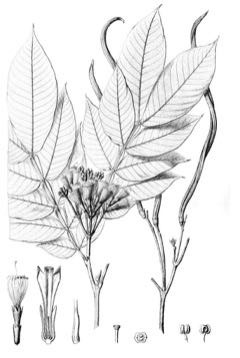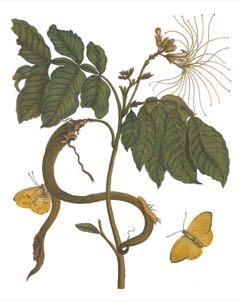 |
|
http://www.edibleplants.org |
 |
| http://www.edibleplants.org |
Translate this page:
Summary
Inga edulis or commonly known as Ice Cream Bean is a fast-growing fruit tree native to South America. It grows up to 30 m tall and 60 cm in trunk diameter. It is an evergreen and forms a broad, spreading canopy. The leaves are compound with 4-6 pairs of leaflets. The flowers re near the ends of branches. It is popular in South America for its edible fruits. The long pod fruits have sweet flavor, white, translucent, jelly-like pulp. Leaf decoctions are used against cough and lip sores. The plant is also planted as shade tree in coffee and cacao plantations. The wood is moderately hard, not very heavy, very durable, and used for making packing cases and piles, and for fuel.
Physical Characteristics

 Inga_edulis is an evergreen Tree growing to 18 m (59ft) by 18 m (59ft) at a fast rate.
Inga_edulis is an evergreen Tree growing to 18 m (59ft) by 18 m (59ft) at a fast rate.
See above for USDA hardiness. It is hardy to UK zone 10.
It can fix Nitrogen.
Suitable for: light (sandy), medium (loamy) and heavy (clay) soils. Suitable pH: mildly acid and neutral soils and can grow in very acid soils.
It can grow in semi-shade (light woodland) or no shade. It prefers dry moist or wet soil and can tolerate drought.
UK Hardiness Map
US Hardiness Map
Synonyms
Feuilleea conferta (Benth.) Kuntze Feuilleea edulis (Mart.) Kuntze Feuilleea scabriuscula (Benth.) K
Plant Habitats
Edible Uses
The pulp surrounding the seeds in the seedpod is white, translucent and jelly-like with a sweet, perfumed flavour[301 ]. Much esteemed in Ecuador, some forms have a slight cinnamon flavour[301 ]. The seedpod is up to 100cm long[335 ]. The seedpod can vary considerably in size and in the quantity of pulp it contains[408 ]. The best forms are found in S. America[408 ].
References More on Edible Uses
Medicinal Uses
Plants For A Future can not take any responsibility for any adverse effects from the use of plants. Always seek advice from a professional before using a plant medicinally.
A decoction of the crushed leaves is taken to relieve coughing[348 ]. A decoction of the leaves is applied to sores of the lips (perhaps herpes)[348 ].
References More on Medicinal Uses
The Bookshop: Edible Plant Books
Our Latest books on Perennial Plants For Food Forests and Permaculture Gardens in paperback or digital formats.

Edible Tropical Plants
Food Forest Plants for Hotter Conditions: 250+ Plants For Tropical Food Forests & Permaculture Gardens.
More

Edible Temperate Plants
Plants for Your Food Forest: 500 Plants for Temperate Food Forests & Permaculture Gardens.
More

More Books
PFAF have eight books available in paperback and digital formats. Browse the shop for more information.
Shop Now
Other Uses
Agroforestry Uses: Commonly planted as a shade tree in coffee and cacao plantations, since it is fast-growing, fixes atmospheric nitrogen, has a well spreading crown and produces large quantities of leaves which cover the ground and add considerable quantities of organic matter to the soil[46 , 408 ]. In trial experiments on cultivated slopes, a mulch from this tree reduced soil erosion to levels almost equal to those in secondary forests[303 ]. The leaf litter is high in nitrogen, lignins and polyphenols. It is slow to decompose, but provides a long-term build up of organic nitrogen and effective weed control. Weed biomass decreased considerably in all agroforestry trials with this species, much more than with other leguminous species. Existing trials are too new to ascertain whether the species can maintain or improve soil fertility on acid sites in the long term, but results so far are promising[303 ]. Other Uses: The heartwood is light brown with dark stripes; the sapwood is pale yellow or almost white. The texture is coarse; the grain straight to interlocked; lustre is medium; there is no distinctive taste or aroma. The wood is not very heavy; hard to moderately hard. It is said to be very durable, even in water[453 , 549 ], though another report says it has low durability and is susceptible to blue stain[363 ]. It is easy to cut, saws slightly woolly and is liable to split in drying. It is used for making packing cases, and especially for making piles[453 , 549 ]. The wood is used for fuel[549 ]. A popular source of firewood, the wood has a high calorific value and burns with little smoke[303 ].
Special Uses
References More on Other Uses
Cultivation details
A plant of the hot, humid, lowland tropics, where it can also be found at elevations up to 2,200 metres[335 , 418 ]. It grows best in areas where annual daytime temperatures are within the range 23 - 30°c, but can tolerate 18 - 35°c[418 ]. Mature plants can be killed by temperatures of -2°c or lower, whilst new growth is damaged at 0°c[418 ]. It prefers a mean annual rainfall in the range 1,200 - 2,500mm, but tolerates 640 - 4,000mm[418 ]. Prefers a sunny position, but also succeeds in dappled shade[418 ]. Tolerant of a range of soil conditions, including limestone[200 ]. It can succeed on floodplains that are waterlogged for 2 - 3 months each year, and is also remarkably resistant to drought, occurring in regions with a 6-month dry season[303 ]. Prefers a pH in the range 5 - 6.5, tolerating 4.5 - 8[418 ]. The tree can grow rapidly, even on the poorest nutrient-depleted soils[303 ]. Seedling trees can commence fruiting when only two years old[335 ]. Trees can flower and fruit all year round[335 ]. The tree responds well to coppicing[303 ]. A highly variable species, forms with the best quality seedpods are seldom found in Central America, where it is quite likely that all the trees are relics of former cultivation[408 ]. This species has a symbiotic relationship with certain soil bacteria, these bacteria form nodules on the roots and fix atmospheric nitrogen. Some of this nitrogen is utilized by the growing plant but some can also be used by other plants growing nearby[755 ]. Flowering Time: Blooms repeatedly. Bloom Color: White/Near White.
References Carbon Farming Information and Carbon Sequestration Information
Temperature Converter
Type a value in the Celsius field to convert the value to Fahrenheit:
Fahrenheit:
The PFAF Bookshop
Plants For A Future have a number of books available in paperback and digital form. Book titles include Edible Plants, Edible Perennials, Edible Trees,Edible Shrubs, Woodland Gardening, and Temperate Food Forest Plants. Our new book is Food Forest Plants For Hotter Conditions (Tropical and Sub-Tropical).
Shop Now
Plant Propagation
Seed - best sown as soon as it is ripe[420 ]. Sow in a lightly shaded position in a nursery seedbed. A high rate of germination can be expected, with the seeds sprouting within a few days. Transplant the seedlings to individual containers when they have 4 - 6 leaves and they should be ready for planting out 4 - 5 months later[420 ]. Greenwood cuttings.
Other Names
If available other names are mentioned here
Ice-cream-bean, pois doux - French, inga-cipó - Portuguese,chalaite - Spanish, cuajiniquil - Spanish, guaba - Spanish, pacay - Spanish. Bribri, Copocoqui, Food Inga, Geli-weko, Guaba, Guama, Guamo, Guavo-bejuco, Huaba, Inga macarrao, Inga-Cipo, Inga-de-macaco, Inga-rabo-de-mico, Krepu uhi, Machete, Pacay, Tite-weko, Warako-sa, guava, wampaa.
Native Range
SOUTHERN AMERICA: French Guiana, Guyana, Suriname, Venezuela, Brazil, Bolivia, Colombia (east), Ecuador, Peru (east),
Weed Potential
Right plant wrong place. We are currently updating this section.
Please note that a plant may be invasive in one area but may not in your area so it's worth checking.
Conservation Status
IUCN Red List of Threatened Plants Status : This taxon has not yet been assessed

Growth: S = slow M = medium F = fast. Soil: L = light (sandy) M = medium H = heavy (clay). pH: A = acid N = neutral B = basic (alkaline). Shade: F = full shade S = semi-shade N = no shade. Moisture: D = dry M = Moist We = wet Wa = water.
Now available:
Food Forest Plants for Mediterranean Conditions
350+ Perennial Plants For Mediterranean and Drier Food Forests and Permaculture Gardens.
[Paperback and eBook]
This is the third in Plants For A Future's series of plant guides for food forests tailored to
specific climate zones. Following volumes on temperate and tropical ecosystems, this book focuses
on species suited to Mediterranean conditions—regions with hot, dry summers and cool, wet winters,
often facing the added challenge of climate change.
Read More
Expert comment
Author
Mart.
Botanical References
1
Links / References
For a list of references used on this page please go here
A special thanks to Ken Fern for some of the information used on this page.
Readers comment
| Add a comment |
|
If you have important information about this plant that may help other users please add a comment or link below. Only comments or links that are felt to be directly relevant to a plant will be included. If you think a comment/link or information contained on this page is inaccurate or misleading we would welcome your feedback at [email protected]. If you have questions about a plant please use the Forum on this website as we do not have the resources to answer questions ourselves.
* Please note: the comments by website users are not necessarily those held by PFAF and may give misleading or inaccurate information.
To leave a comment please Register or login here All comments need to be approved so will not appear immediately.
|
|